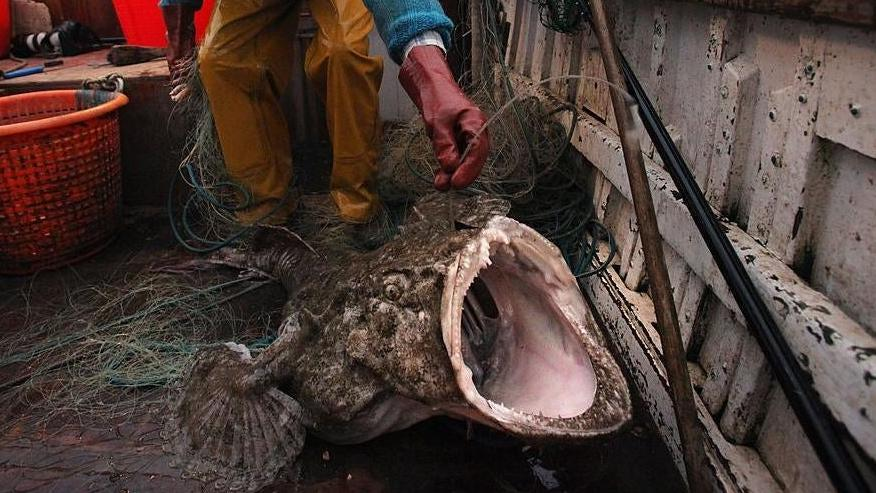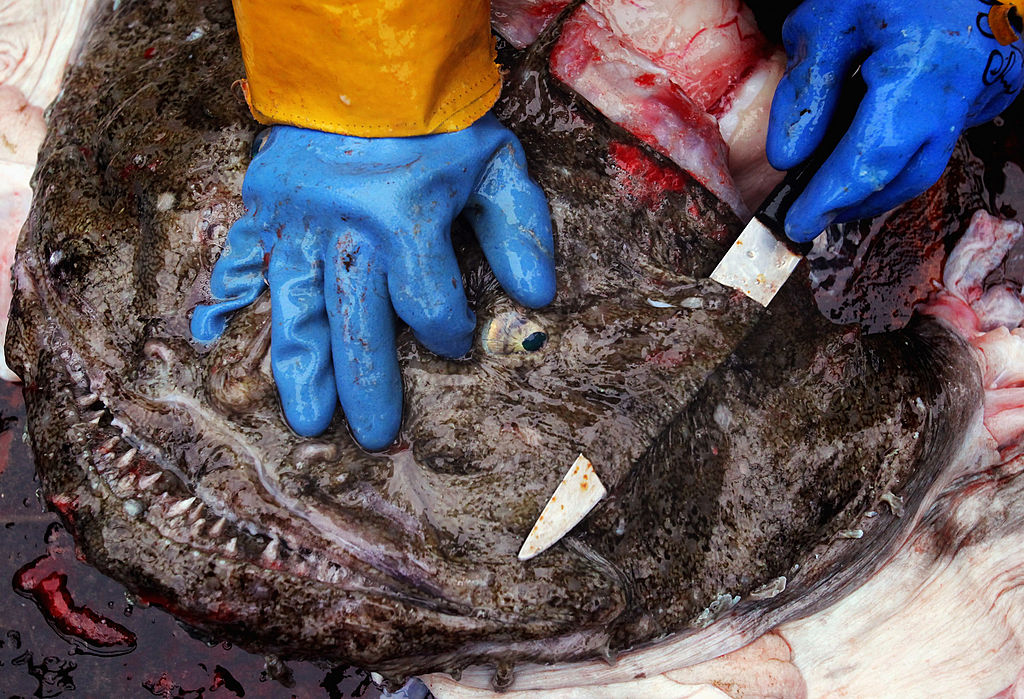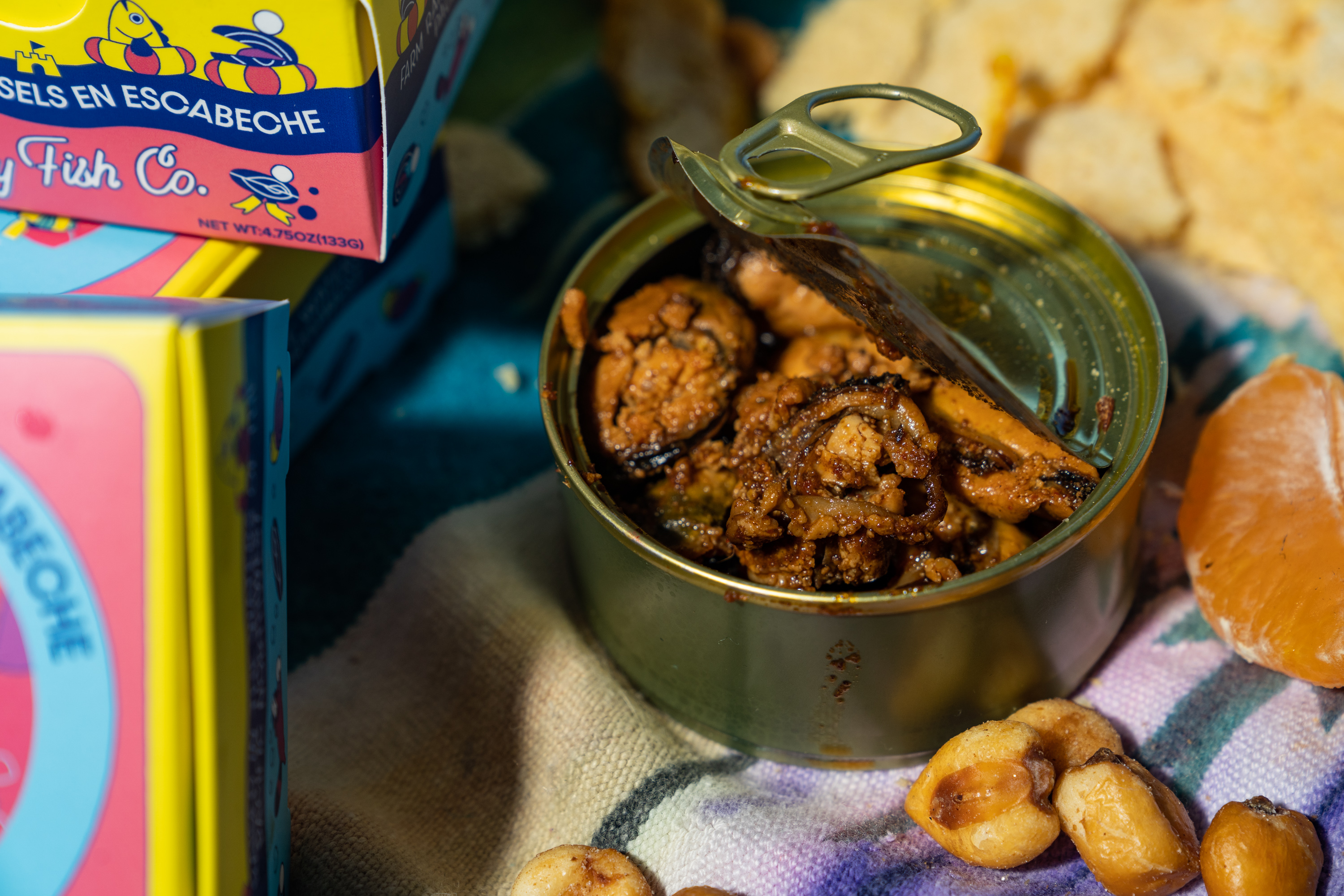Your Diet Needs More Ugly Fish
Chefs, fishermen, and conservation groups across the country are touting the joys of hideous seafood.
To peer into the eyes of a monkfish is to come face-to-face with death. The massive fish grow to between three and five feet in size, but their heft is far from their creepiest quality. Much worse is the fish's ugly mug: beady eyes, a wide, gaping mouth, and stalactite rows of jagged teeth. Monkfish are also carnivorous, feasting on shrimp, squid, and even some seabirds, though humans thankfully aren't in their rotation. Still, encountering a monkfish is enough to inspire kraken-level terror in the average consumer. One advocacy group wants you to eat them anyway.
Since 2020, the Maine Coast Fishermen's Association (MCFA) has been working to spread the gospel of monkfish among hesitant Americans. Monkfish is nutritious, meaty, and easy to prepare—but its fearsome visage is enough to scare away many would-be consumers, especially in North America. (The fish's snowy white tail meat is enjoyed as a delicacy in countries like France and Japan.) The MCFA isn't the only organization hoping to open consumers' eyes to intimidating seafood delights; chefs, advocacy groups, and fishermen are urging consumers to eat more ugly fish across the country.
Ugly fish are key to resilient fisheries
The mighty monkfish may be a grotesque bottom-feeder—but it also tastes great. Monkfish is known for its firm, succulent tail meat, hence its unofficial status as the "poor man's lobster." Monkfish is also nutritious, packed with protein and key vitamins. Even better, it's easy to prepare—the fillets can be cut into steaks, but the meat also holds up remarkably well in stew dishes thanks to its firm consistency. That's great news for the MCFA, says executive director Ben Martens. The organization is currently engaged in what Martens jokingly calls "stew-ardship"—familiarizing Mainers with monkfish via a frozen stovetop stew made in collaboration with a local culinary brand.
The initiative began in late 2020, when the MCFA launched a program called Fishermen Feeding Mainers. The organization worked with fishermen to donate their excess catch—monkfish included— to local food-insecure populations. As the program took off, Martens realized that he had overestimated the community's familiarity with monkfish.
"One of the things that has been really interesting is how different communities have responded to different types of fish we're donating," Martens says. "Things like haddock or pollock—people know how to deal with those things. But monkfish was really new for a lot of the communities in Maine. People would say, 'Oh, this has a different consistency than the flaky fish I'm used to—what am I supposed to do with this?'"
Of course, monkfish isn't new to the U.S. culinary scene. Julia Child advocated for the monstrous fish, calling it "a cook's delight" in her book, Julia Child & Company. She writes: "Monkfish is a cook's delight because it's so adaptable; its firm texture suits it to dishes like bouillabaisse, and its mild flavor can be stepped up with marinades and sauces." Child's endorsement led to a spike in monkfish popularity in the early 1980s; unfortunately, as Martens explains, the fish has since drifted back into oblivion. And for Gulf of Maine fishermen, that's a problem.
First, Martens explains, most reliable monkfish markets are overseas, which is a tough break for fishermen seeking a consistent bottom line. "Our fishermen go through massive swings of what you might get paid for monkfish, and that can make or break a fishing trip," Martens says.
There's also a sustainability aspect to consider, as under-appreciated ocean-dwellers like monkfish can help relieve overfished species. "Monkfish is typically a fish you catch when you're targeting other species," Martens says. "So if you're trying to catch cod, haddock, flounder—some of the more popular fish—you might catch monkfish incidentally. But if you're able to build a business targeting monkfish, it's an opportunity to rebuild those other species that may have been overfished. That helps ensure that we have a healthy fish stock in the Gulf of Maine."
So, how can fishermen spread the word about monkfish's myriad benefits? First, the MCFA created a series of recipe cards to instruct consumers on monkfish storage and preparation methods. Next, they worked to lower the barrier to entry the best way they could: with a tasty entree. The MCFA partnered with Maine-based Hurricane's Premium Soup & Chowder to create a ready-made frozen stew with the goal of thrusting the fish into the mainstream. "[The stew is] hearty, with lots of vegetables and monkfish," Martens says. "It's really got a great flavor."
Now, the monkfish stew is sold in 17 different locations in Maine. Martens is convinced that the organization's efforts are working. "One of the anecdotal things we're hearing from partners in local fish markets is they're also seeing a significant rise in people buying monkfish," Martens says. Meanwhile, he says that he's seeing monkfish hitting the menu at restaurants in surprising ways—in hot dogs, for example. "The more we talk about monkfish, the more we can build a growing awareness so people are willing to take more of a risk on it," he says.
Creepy seafood, pretty packaging
If the MCFA project is any indication, consumers respond extremely well when underutilized fish are incorporated into ready-to-eat entrees. After all, when you're eating monkfish in pre-made stew, it's easier to ignore the fish's toothy grin and creepy scales. That's the idea behind Tiny Fish Co., a trendy tinned fish business founded by Top Chef alum Sara Hauman. Hauman founded the company after a stint working at the iconic Asador Etxebarri in the foothills of Spain's Basque region.
While living in Spain, Hauman relied on baguettes with cream cheese and tinned fish for quick after-service meals. She also garnered inspiration for her signature boquerones, a signature dish during her time as a chef at Huxley in San Francisco's Tenderloin district. "I started thinking about how to bring a product like boquerones to market," she says. She decided to draw inspiration from her grandmother, a canning enthusiast who packed her Illinois basement with perfectly preserved foods. Finally, after competing on Top Chef and securing funding from an investor, Hauman combined her two fascinations to produce a tinned fish line introducing consumers to underutilized seafood. Through Tiny Fish Co., Hauman asks: can ugly fish become hot girl food?
Take geoduck, for example. Geoduck is not, in fact, a duck; it is a giant clam. The largest burrowing clam in the world, to be precise, and one that, as Serious Eats writer Naomi Tomky puts it, looks like "the grotesque, wrinkled schlong of a deformed hippopotamus." TikTokers are obsessed with it for exactly that reason—but Hauman loves it for its versatile meat and ready availability in the Pacific Northwest, where her business is based. "It's definitely hard to get past the appearance," she admits. "But I really love [geoduck] because you get a lot of different textures. The longer part outside of the shell—all you have to do is blanche that, pull off the outer skin, and slice it raw like sashimi or ceviche. The inside shell is stronger-tasting like crab or lobster, and that's really great fried."
The same goes for rockfish, another of Hauman's signature tinned products. Hauman refers to rockfish as a "bycatch"—an underutilized animal that may be caught alongside more commercially popular fish, but will sell for much less given its relative unpopularity. "We want to honor the animal that the fishermen are bringing in alongside those popular fish," Hauman says. "At the end of the day, it would be hugely wasteful to just discard it."
Fortunately, rockfish are also packed with flavor, making the fish a great protein to use in noodle dishes or brandade. It's also extremely nutrient-dense. "When most consumers are looking at tinned fish products, they're looking for buzzwords like 'wild-caught,' 'natural,' or 'high in omega 3s,'" Hauman says. "Yes, fish like salmon have all of those things—but so do rockfish."
Eating monsters for dinner
Monkfish, rockfish, and geoduck may be ugly, but they're also symbiotic members of their native marine communities. Not so for Asian carp, the massive invaders currently consuming Midwestern waterways. While Asian carp aren't particularly ugly, they are known for decimating native fish populations and creating unsafe fishing environments with their signature writhing. That's why, in 2020, Chicago restaurants mounted the Asian Carp Challenge, an effort to tantalize consumers into eating the underwater invaders.
A few years prior, a similar movement spread among conservation-minded chefs in Bolivia's metropolitan areas. They were working to slow the destruction wrought by paiche, an invasive fish which can weigh up to 400 pounds and was wreaking havoc on Bolivian freshwater fish populations. Unfortunately, the effort worked a bit too well, and some chefs were criticized for increasing paiche demand and, consequently, intentional paiche cultivation. For Scientific American, Michael Snyder writes:
"Bolivia is now faced with a controversy that, for the past decade, has been a central debate in the young field of invasion ecology here in U.S.: Could human hunger help control the spread of invasive species, or will the rules of capitalism, combined with our unquenchable thirst for more, only make matters worse?"
Fortunately, monkfish and rockfish are far from problematically abundant. They're just under-appreciated—and increasing demand could be the key to building more sustainable coastal communities.
"That's how you build resilient fisheries on the water and onshore," Martens says. "If we're only listening to the markets, that pushes us to only catch cod. But if we're looking to the future—if we're trying to build those markets and keep them sustainable—it's time to start talking about other fish.


